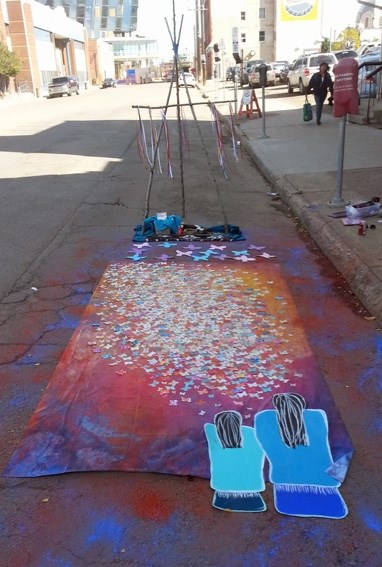A butterfly must overcome significant odds during its lifetime. In order to transform and survive, it needs to be resilient. The butterfly metaphor drew in Dawn Marie Marchand, an Edmonton-based Cree/Metis artist from Cold Lake First Nation.
A butterfly must overcome significant odds during its lifetime. In order to transform and survive, it needs to be resilient.
The butterfly metaphor drew in Dawn Marie Marchand, an Edmonton-based Cree/Metis artist from Cold Lake First Nation. As part of a city initiative called Parking Day to transform parking spaces into art installations, she created an installation called kamamak - Cree for butterfly - to bring awareness to murdered and missing indigenous women.
On Sept.18, a chilly and overcast afternoon, Marchand had 1,186 butterflies attached to a drop cloth on-site, each commemorating the life of an indigenous woman lost, based on numbers from a 2014 RCMP report - each butterfly, manipulated either by drawing, colouring or painting, set against a backdrop bathed in the gold, crimson and blue of a late sunset, as day turns to night.
Marchand based the installation on a painting she did for the Edmonton Native Healing Society, which was gifted to the Edmonton Police Service. The butterfly idea came from Winnipeg artist Jackie Travers, who had been tagging the inner city with butterflies to commemorate the lives of the murdered and missing.
"I was approached to do a painting that was going to be gifted to the Edmonton Police Service and I suggested that we use the butterfly metaphor because I think it's so beautiful," says Marchand. "That's where the original painting came from and I just wanted to recreate it, but instead of one butterfly for every 10 murdered and missing indigenous women, I wanted to see what it would look like if we actually put all of them down."
Her potent installation elicited both appreciation and sadness from audiences.
"A lot of people were like 'Oh, it's so beautiful,' but then they found out what the meaning behind those butterflies was and they were like 'Wow, it's so beautiful and yet it's so painful,'" she says. "When you saw over a thousand butterflies in one place and then you realize that each one was a life and that each of those lives were interconnected to the rest of the community, people really felt it."
"It was very, very powerful," says Aretha Greatrix, who visited the installation and knows Marchand from her work as a community artist. "A lot of the women have gone missing and murdered from Edmonton, so it just set the environment of it."
"I actually had attended with my mother as well, who is a residential school survivor and she even said 'You know I bet you I even know some of those people,'" says Greatrix. "There were a lot of times when I had to fight back tears as we were having these conversations."
While the installation represented each missing and murdered woman, it also prompted people to talk about those indigenous women that narrowly missed becoming one of the missing and murdered.
"If we accumulated that in there there's a lot of butterflies that should be down there as well," said Greatrix.
"This whole idea came from her listening to the people," says Greatrix, praising Marchand's expressive and political art. "That is the most powerful - when you're listening to the people and kind of encapsulating what everyone has said in an image and it's so emotional it strikes everyone."
Marchand has been a full time artist for four years. She has also worked in education, including being an Aboriginal Student Assistant at Assumption Jr./Sr. High School. She has used art and culture to engage at-risk youth.
"The idea of doing installations that is community-minded, it's work that I've done for some time," she says. Growing up, Marchand moved between the Lakeland and Edmonton. In the region, her artwork has been showcased at the Kehewin Cree Nation's Community Centre.
She is currently working on a project to help revitalize the Cree Language. She illustrated a story for the Cree Literacy Network from Sweetgrass First Nations about horses. She is hopeful the book will be published next year.
Her work focuses on taking art to public spaces to create new conversations around indigenous issues. She hopes to inspire a change in the dialogue about missing and murdered indigenous women through kamamak.
"The conversations need to be less about victim blaming and more about what are the systemic barriers in the lives of people?" says Marchand. "So that conversation needs to transform to be more inclusive."
However, she acknowledges the challenges along the way. One requires resilience to overcome the barriers in achieving that transformation.
Much like a butterfly.
